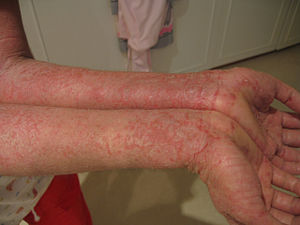Eczema: Difference between revisions
Jump to navigation
Jump to search
Kingrajinix (talk | contribs) |
Kingrajinix (talk | contribs) |
||
| Line 16: | Line 16: | ||
===Clinical Features=== | ===Clinical Features=== | ||
Essentially it's '''itchy, red, dry skin''' which, contrary to [[psoriasis]], tends to appear of the '''flexure''' regions i.e. backs of elbows and knees, fronts of ankles and around the neck. | |||
*Tendency towards dry skin throughout life | |||
*Along with redness and itching, acute flare-ups my have [[vesicles]], scaling, cracking, crusting and swelling of skin. | |||
*Scratching repeatedly leads to lesions thickening | |||
*Eczema can involve the face in the young | |||
*''Bacterial infectin'' - crusting, weeping, pustulation, surrouding [[cellulitis]] | |||
*''Eczema herpeticum'' (i.e. [[herpes]] infection) - worsening or painful; clustered blisters with early-stage cold sores; circular, depressed, ulcerated lesions ("punched-out") 1-3mm and uniform; fever, lethargy and distress | |||
===Investigations=== | ===Investigations=== | ||
===Management=== | ===Management=== | ||
===Prognosis=== | ===Prognosis=== | ||
Revision as of 12:04, 9 December 2009
Definition
A form of dermatitis (epidermal inflammation). It represents a range of conditions.
Epidemiology
Affect 15-20% of school children and 2-10% of adults. Over 80% of cases prevent before the age of 5. It's slightly more common in females than in males.
Pathophysiology
Eczema is generally atopic i.e it is due to a hypersensitivity reaction. There are loads of things that exacerbate it outline in the risk factors on this page.
Risk Factors
- Genetic - having an affected parent increases likelihood of developing disease
- Environmental - irritants such as soap and detergents; S. aureus; extremes of temperature and humidity i.e. summer and sweating worsen condition; abrasive fabrics like wool; inhaled allergens; house-dust mite, pollens, pet hair, mould; some dietary factors
- Endogenous - stress; hormonal changes in women.
Clinical Features
Essentially it's itchy, red, dry skin which, contrary to psoriasis, tends to appear of the flexure regions i.e. backs of elbows and knees, fronts of ankles and around the neck.
- Tendency towards dry skin throughout life
- Along with redness and itching, acute flare-ups my have vesicles, scaling, cracking, crusting and swelling of skin.
- Scratching repeatedly leads to lesions thickening
- Eczema can involve the face in the young
- Bacterial infectin - crusting, weeping, pustulation, surrouding cellulitis
- Eczema herpeticum (i.e. herpes infection) - worsening or painful; clustered blisters with early-stage cold sores; circular, depressed, ulcerated lesions ("punched-out") 1-3mm and uniform; fever, lethargy and distress
